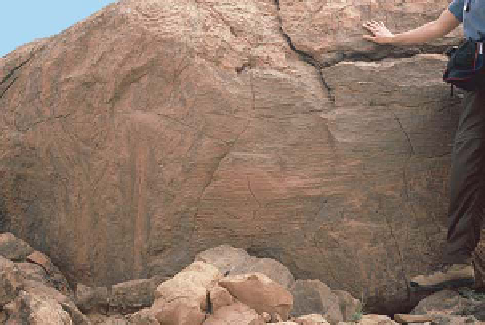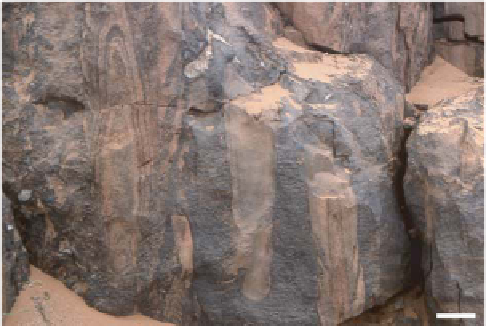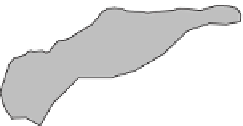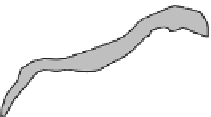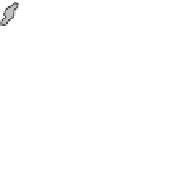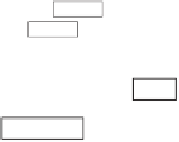Geology Reference
In-Depth Information
(a)
2
5ºN
Algeria
Chegga
Atlantic
Ocean
Grizim
El Mreiti
Aguelt
el Mabha
20º
Atar
Mali
Richat
C
Mauritania
J
Taoudenni
Basin
Nouakchott
1
5º
500 km
Africa
20 cm
1
0ºN
(b)
Legend of Symbols
Post Pan-African Cover
Assabet el Hassiane Group
Pan-African Orogenesis
Archean-Paleoproterozoic Basement
Atar Group
Char Group
Pan-African Sutures
Fig. 2.
Regional extent of the Atar Group. Atar Group strata
are exposed in a continuous belt across the West African
craton from Mauritania to western Algeria. Atar Group
strata unconformably overlie predominantly siliciclastic
strata of the Char Group, onlap Archaean-Palaeoproterozoic
rocks of the Regubiat Shield and are overlain by silici-
clastic strata of the Assabet el Hassiane Group. Variously
deformed, stromatolitic strata in the Hoggar Uplift, Mali
and Algeria, may represent depositional equivalents to the
Atar Group (Bertrand-Sarfati & Trompette 1976; Bertrand-
Sarfati
et al.,
1987).
J
J
T
20 cm
Fig. 1.
Enigmatic juxtaposition of stromatolite forms in
the Atar Formation. (a)
Conophyton
-
Jacutophyton
in the
R1 reef interval. (b)
Jacutophyton
-
Tilemsina
in the R2 reef
interval.
and virtually undeformed Proterozoic strata that
crop out in a sinuous belt spanning >1500 km from
Mauritania to northern Mali and Western Algeria
(Fig. 2). Strata unconformably overlie Archaean
amphibolite and quartzo-feldspathic schists
and Palaeoproterozoic granitic intrusions of
the Reguibat Shield (Black & Fabre, 1983;
Trompette & Carozzi, 1994) and are in turn uncon-
formably overlain by Vendian (or Cambrian) and
younger strata (Clauer & Deynoux, 1987; Bertrand-
Sarfati
et al.
, 1995).
Proterozoic strata of the Taoudeni Basin are
typifi ed by well-exposed sections in the Adrar
Mountains of Mauritania, where the succession
is subdivided into three unconformity-bounded
groups (Figs 2 and 3). Potentially correlative and
similarly subdivided strata are also exposed in
the Hoggar uplift of Algeria (Moussine-Pouchkine
et al.
, 1988; Bertrand-Sarfati
et al.
, 1991, 1996;
Moussine-Pouchkine & Bertrand-Sarfati, 1997)
and in several poorly studied exposures in the
southern Taoudeni Basin (Bertrand-Sarfati &
Moussine-Pouchkine, 1983; Bertrand-Sarfati
et al.
,
1987). At the base of the succession, coarse- to
grew on this rugged surface, fi lling space between
the high-relief cones. The resultant stromatolite
biostrome exhibits lateral partitioning of time, with
conical stromatolite growth dominating during
relative sea-level rise and domal to columnar stro-
matolite growth occurring during times of lower
accommodation space (Kah
et al.
, 2006).
In this paper, we provide a stratigraphic
interpretation of the enigmatic Atar Formation
Conophyton-Jacutophyton
biostromes. Here, we
(1) document superpositional relationships among
stromatolitic elements in the Atar Formation bio-
stromes; (2) interpret stromatolite growth in terms
of relative sea-level change; and (3) explore stroma-
tolite and sea-level relationships in terms of basin
geometry and Proterozoic carbonate dynamics.
GEOLOGICAL SETTING AND AGE
The Taoudeni Basin, West Africa, preserves up to
1300 m of gently dipping (<1°), unmetamorphosed,
